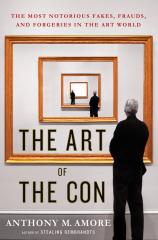 Anthony M. Amore is no stranger to the world of art crime: Not only is he the head of security at the Isabella Stewart Gardner Museum, he also serves as trustee of the Association for Research into Crimes against Art. Art theft is a captivating subject because it combines the high world of art with the grittier crime world...and, let’s face it, everyone loves a good heist (except, perhaps, its victim). In THE ART OF THE CON, Amore shares his considerable knowledge to tell the stories of some of history’s most notorious yet untold cons. Here, he talks about his favorite art theft book --- besides his own, of course. Hint: It’s not what you think!
Anthony M. Amore is no stranger to the world of art crime: Not only is he the head of security at the Isabella Stewart Gardner Museum, he also serves as trustee of the Association for Research into Crimes against Art. Art theft is a captivating subject because it combines the high world of art with the grittier crime world...and, let’s face it, everyone loves a good heist (except, perhaps, its victim). In THE ART OF THE CON, Amore shares his considerable knowledge to tell the stories of some of history’s most notorious yet untold cons. Here, he talks about his favorite art theft book --- besides his own, of course. Hint: It’s not what you think!
Over the past few years, and especially since the publication of my first book, STEALING REMBRANDTS, I have given a great many lectures on the topic of international art theft. The talks typically bring in a good size audience. That’s not a boast: I am well aware that the topic sells itself, and people come out more because of their fascination with the art crime than out of any fanatical desire to see me (I suppose that’s for the best --- I’m hardly Pierce Brosnan.)
After I tell my true tales of pilfered paintings, I always take questions, and they run the gamut from disbelief (“Are you sure there isn’t really a Dr. No figure out there with a collection of stolen masterpieces?”) to speculative (“I think my brother-in-law has a stolen painting.” Note: it’s always the brother-in-law for some reason).
One enjoyable question that comes up very often is “What is your favorite book on art theft?” I like this question for two reasons: First, it gives me yet another opportunity to plug my own work; after all, that’s why I’m there. And second, I have a surprise answer --- it’s THE LOST PAINTING by Jonathan Harr, a book that is not about art theft at all.
So why, then, do I recommend THE LOST PAINTING? For starters, while the book doesn’t involve the theft of a painting, it does revolve around the hunt for a lost treasure: Caravaggio’s The Taking of Christ. The author masterfully depicts the obsession that builds in two separate individuals: researcher Francesca Cappelletti and conservator Sergio Benedetti. It’s the sort of intense work that both of them do before their lives become intertwined over the Caravaggio masterpiece that rings true of the work involved in looking for stolen paintings (save for the requisite back-alley meetings with underworld figures, of course). The book provided me with a primer on provenance and paintings conservation in a compelling way. And Harr’s ability to write a gripping detective story is matched by his skill in writing about art history. I was completely engrossed by the way he described the chaotic genius of Caravaggio.
That leads me to the second reason the book ranks atop my list of art theft books: the writing of Jonathan Harr. THE LOST PAINTING is a quintessential page-turner. It’s one of those rare works that leads the reader to remember not just the story but the experience of reading the book. I recall where I was when I read the first half of the book in one sitting, where I was when I finished it, and the conversations that it sparked with my colleagues in both the museum and investigation worlds. Not coincidentally, Harr’s A CIVIL ACTION gave me the same sort of experience.
My final reason for recommending THE LOST PAINTING is just personal: nostalgia. I read the book during the early part of my investigative work in art theft, and it brings back memories about information that I now know by heart and have seen firsthand. However, when I first dove into Harr’s masterful prose, concepts like relining a centuries-old canvas or digging through the family archives for ownership information were foreign to me. Now that I’m much better acquainted with these practices, I’m still reminded of the mental images I formed while reading about the work that went into finding and identifying The Taking of Christ.
I can’t say that my answer always satisfies my interrogator. Every so often, I’ll be pushed to name a book about actual thefts. So, again, I cite my own work, and then mention Milton Esterow’s THE ART STEALERS, a book that is now out-of-print but certainly worth hunting down. It was an inspiration for my own books and a great introduction to how art crime really happens.



